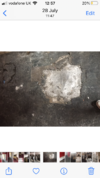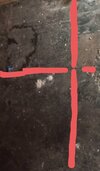Hiya
New here. I am buying a house that needs a bit of tlc. It has a quite big kitchen extension with ck Crete floor covered in layers of rubbery stuff. There is a hole in the middle of the rubbery stuff. See pic.
This hole is in front of the sink which has clearly leaked some due to state of the unit. Could this have damaged the rubber - or something else?
I want to put down oak laminate in here and wonder how I patch this up best so I can do so.
Many thanks
New here. I am buying a house that needs a bit of tlc. It has a quite big kitchen extension with ck Crete floor covered in layers of rubbery stuff. There is a hole in the middle of the rubbery stuff. See pic.
This hole is in front of the sink which has clearly leaked some due to state of the unit. Could this have damaged the rubber - or something else?
I want to put down oak laminate in here and wonder how I patch this up best so I can do so.
Many thanks




